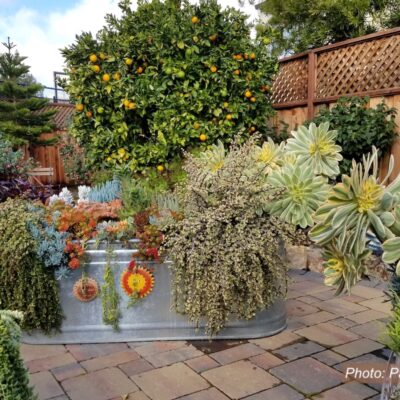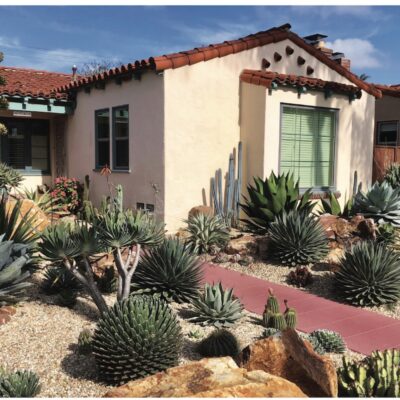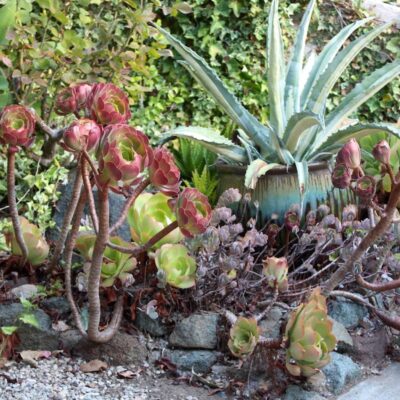Want to transform your yard into a low-maintenance, low-water succulent garden? This page guides you to helpful info on this site and on my YouTube channel. Before you purchase plants or pick up a shovel, do obtain my book Designing with Succulents (2nd ed). It's mainly about in-ground gardens.
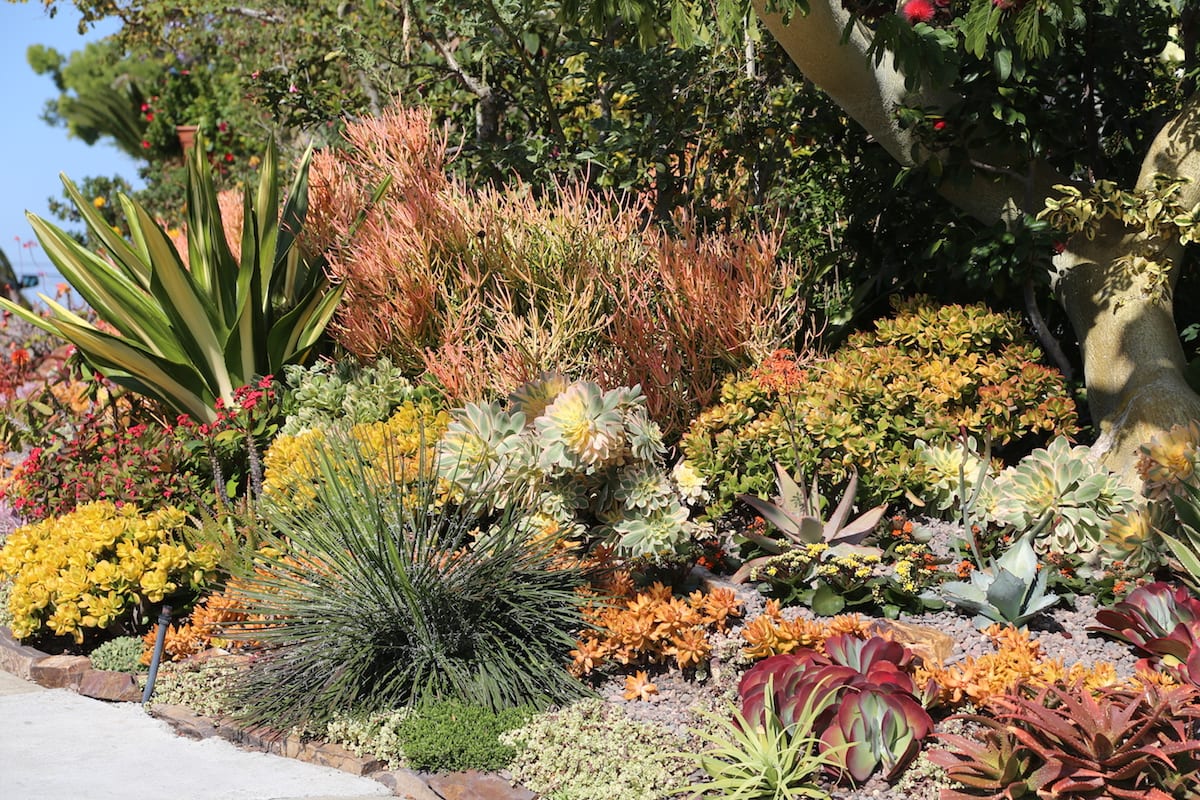
A streetside garden in San Diego is a jewel box of succulents. Design by Michael Buckner and homeowner Lila Yee.
Lawn to Succulent Garden
OK, you've let your lawn die. (Insert applause emoji.) Here's how savvy, succulent-loving homeowners went from turf to terrific.
Nancy Dalton's front yard succulent garden in Carmel Valley, CA won a waterwise award. See the video.
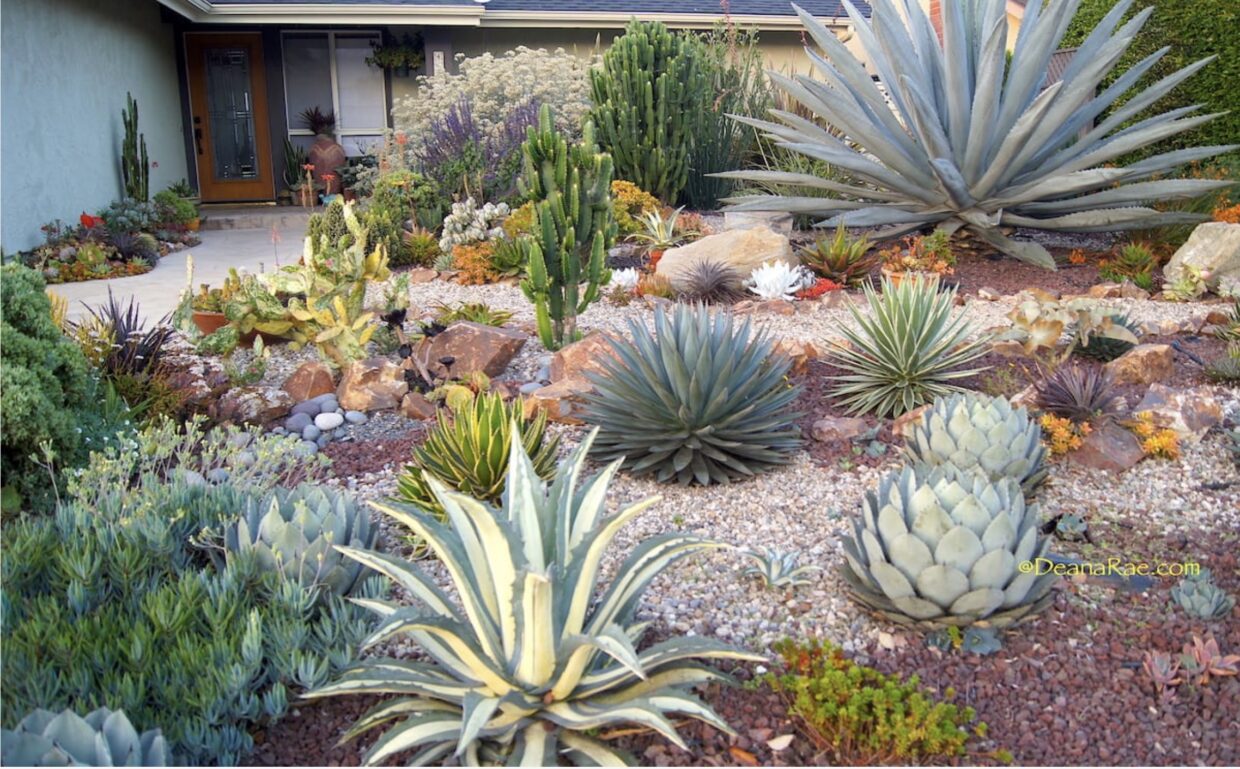
This front yard succulent garden, by homeowner Deana Rae McMillion of Carpinteria, CA, illustrates my Ten Front Yard Essentials.

Ten Succulent Front Yard Essentials
#1: Know how large plants will get. For example, Agave americana, though easy to grow and often free for the asking, isn’t for every garden. (See my video, “What You MUST Know About Century Plants.”)
#2: Ask friends and neighbors for succulent cuttings. If you’re not going to put them in the ground right away, start them in pots.
#3: If soil is compacted and difficult to dig, give succulent roots a fighting chance by spading it and adding amendments prior to planting.
#4: To add interest and definition to the overall design, bring in large boulders. They weigh tons, so have them delivered and positioned BEFORE you plant.
#5: Don’t skip the infrastructure. Take care of pre-planting steps like installing and adjusting irrigation, evaluating runoff, repairing drains and walls, and upgrading hardscape.
#6: Design with undulating lines for a natural look. Straight lines and rows are more formal, seldom found in nature, and emphasize the linearity of nearby structures.
#7: In close-up areas, create complex plantings. Viewpoints that are broader and farther away need less detail and larger plants.
#8: Top-dress with crushed rock (gravel). Imagine this garden with only bare dirt between plants. Topdressing finishes a landscape aesthetically; adds interest, color and texture; discourages weeds and makes them easy to pull; moderates soil temperature; and slows moisture evaporation.
#9: Continue rocks and gravel into the parkway strip. This enhances the overall design, makes the front yard larger, and makes what’s sometimes called a “hell strip” easy to maintain.
#10: Include intriguing plant-rock combos within the larger garden. Such “vignettes” are optional, but offer a great way to express your creativity, enjoy your garden hands-on, and offer visitors delightful discoveries.
Smart Design and layout
If you're overwhelmed by the complex task of redoing a large yard, consider hiring a landscape designer. She or he can help you with part or all of the process: lawn removal, irrigation (yes, succulents need some water), hardscape, plant selection and placement.
A garden should be practical, inviting and beautiful. Important considerations include climate, orientation to the sun, soil quality, grade changes, and---most importantly---what you hope to achieve: a backyard retreat, perhaps, or curb appeal that increases the value of your home.
Videos
Patrick Anderson's Succulent Garden: It All Started with Aloes (6:07) How a well-designed succulent garden looks two decades after installation.
Find out how celebrity designer Laura Eubanks creates a Succulent Pocket Garden (12:37) and learn her Succulent Garden Design Secrets (3:40).
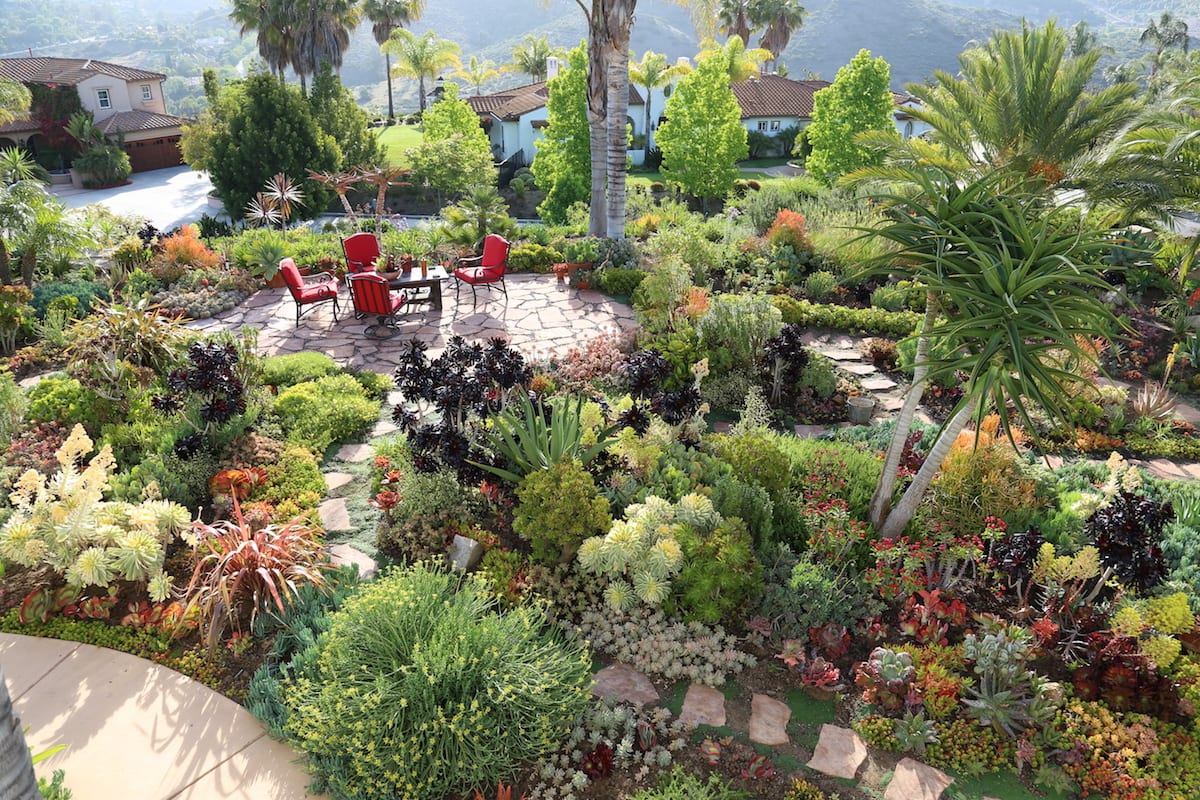
A landscape by Linda Bresler in Poway, CA. From Designing with Succulents, 2nd ed. Photo by Ed Gohlich.
Design Essentials: Rocks and Topdressing
Rocks enhance succulent gardens of every size. Rocks and topdressing (gravel) moderate soil temperature, keep weeds from germinating, need no maintenance, and look good year-round. Find out more about this essential design element in my videos:
Videos
Why You Really Need Rocks (5:32). Succulent landscape designer Steve McDearmon uses warm-toned boulders, rubble and gravel.
A Succulent Boulder Garden (4:06). Why you should be very glad if you have huge rocks.
Succulent Design Ideas from Sherman Gardens (4:18). A small garden with big ideas includes rivers of rock and mosaic.
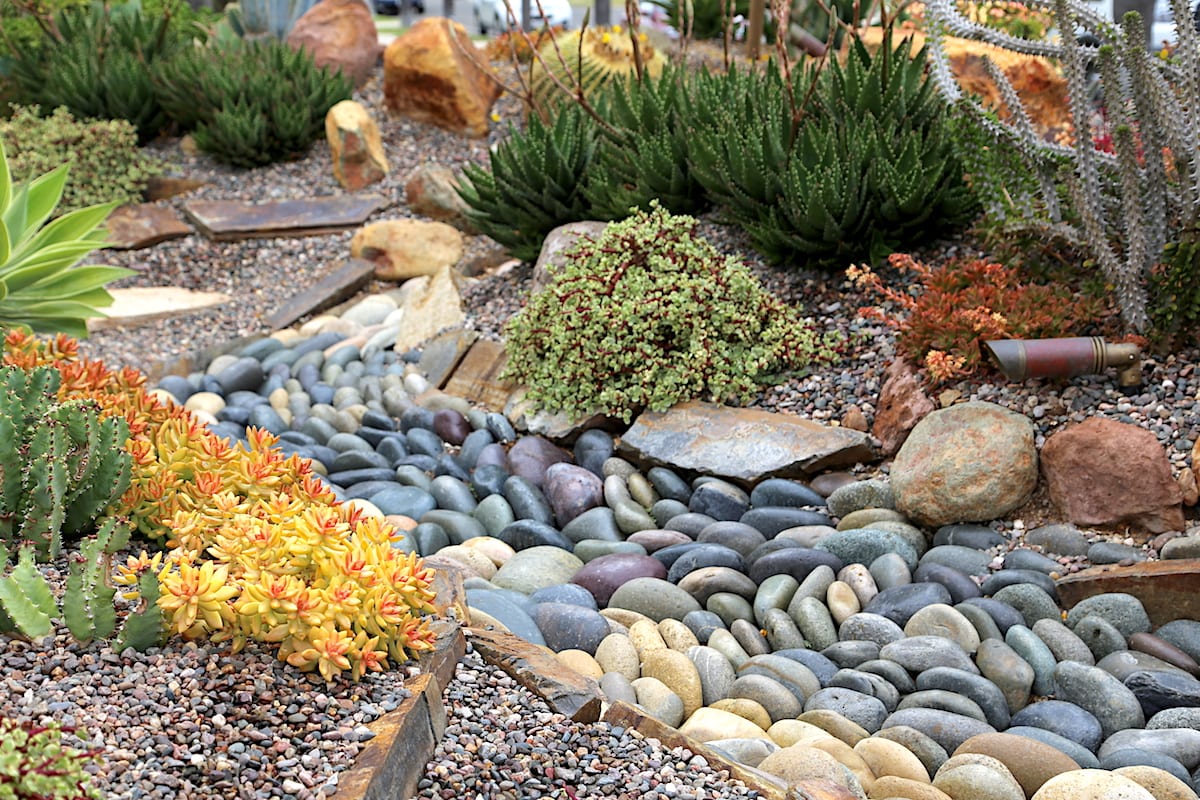
In this front yard landscape by Michael Buckner is a dry creek bed of rounded river rock. Do you see several other kinds of rock as well?
Trees and non-succulent companion plants
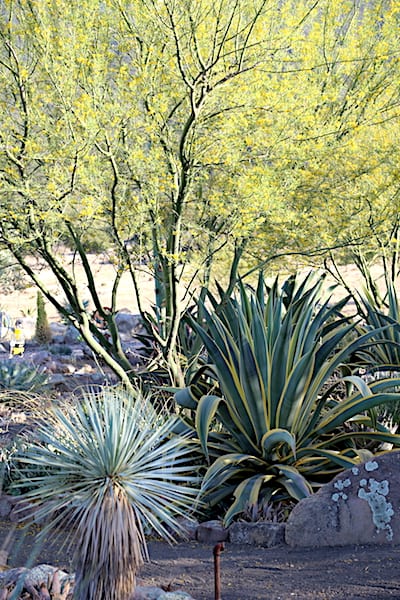
Palo verde tree
There are indeed succulent trees, such as Aloe 'Hercules', Dracaena draco, and Beaucarnea recurvata. As it happens, they resemble those in children's books by Dr. Seuss.
Succulent trees may have great personality, but they provide minimal shade unless large, which takes forever. And even when small, they tend to be expensive. A smart alternative is to provide shade by planting lovely, non-succulent trees that once established, need minimal water.
Palo verde is a desert tree that does fine closer to the ocean. It gets by on rainfall, blooms for months, and provides a lacy canopy. How much do I love this green-barked beauty? I have seven palo verde trees in my half-acre, Zone 9b garden.
Trees, btw, are the first things to plant. Don't start with the small stuff. Most gardens need shade ASAP, and even a relatively fast-growing tree---like Acacia longifolia---can take three to five years to provide it.
Select the Right Succulents
An entire chapter of Designing with Succulents (2nd ed) is all about suitable succulents. The key is to select those that you enjoy looking at, and to prepare beforehand for their care requirements and possible drawbacks.
For example, rather than put up with the feral-cat characteristics of century plants (Agave americana), select Agave cultivars that stay reasonably small, don't produce invasive pups, take a long time to bloom (a good thing), and are truly beautiful.
Of course you can have a century plant if you want one...they're usually free for the asking (that pupping thing). In fact, the only plant in my garden I've truly mourned was "Big Blue," an Agave americana I'd planted as a pup and that bloomed and died at 23.
Critique: Expensive Mistakes in a Grand Succulent Garden (6:23) Below: Find out what this public installation does right, and---perhaps more importantly---what it doesn't.
Related info on this site
Wheelchair Accessible Succulent Garden
When I saw the photos that “Celebrating the Joy of Succulents” newsletter subscriber Pat Armanino emailed me of her garden, I knew I wanted to share them. Pat’s use of galvanized water troughs as succulent containers is clever and eye-catching. But her main reason for using troughs, she told me, is that they make gardening…
15 Thrifty Tips for Low-Water Landscapes
My 15 simple, economical fixes for a 2-1/2 acre Santa Barbara wedding venue emphasize succulents and apply to any low-water, mild-climate landscape.
A Dozen Beginners’ Succulent Landscape Mistakes
As a succulent garden consultant, I often see these dozen common landscaping mistakes made by well-intended homeowners. Correcting them makes a big difference aesthetically. Do any apply to you? If not, applause!
No-Water Succulents for Southern California Gardens
Above: I based one of my most popular videos on the agave section of my bestselling book, Designing with Succulents. Both explain what you need to know to select and grow agaves successfully, and both show those best for gardens, close-up and in-ground. Some agaves are hardy to 15 degrees or less! And when small,…
How to Redo an Overgrown Succulent Garden
Every three or four years I redo this succulent garden outside my office window. Last time was 1-1/2 years ago when I added the fountain. It’s an important view area because I spend so much time…uh…gazing outside instead of working. (I can’t help it. The fountain doubles as a bird bath.) In my YouTube video, How to Refresh an Overgrown Succulent Garden, I…

